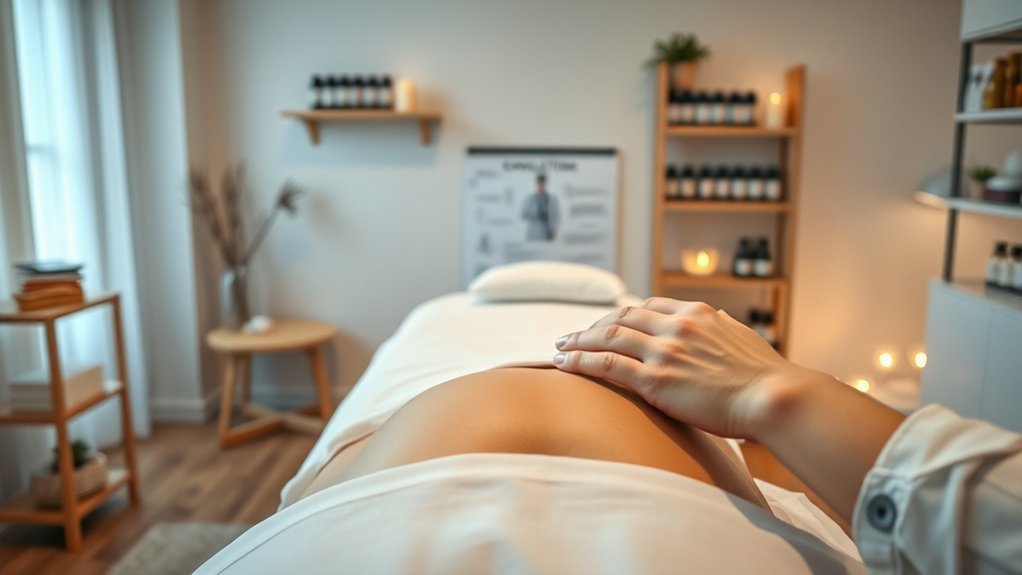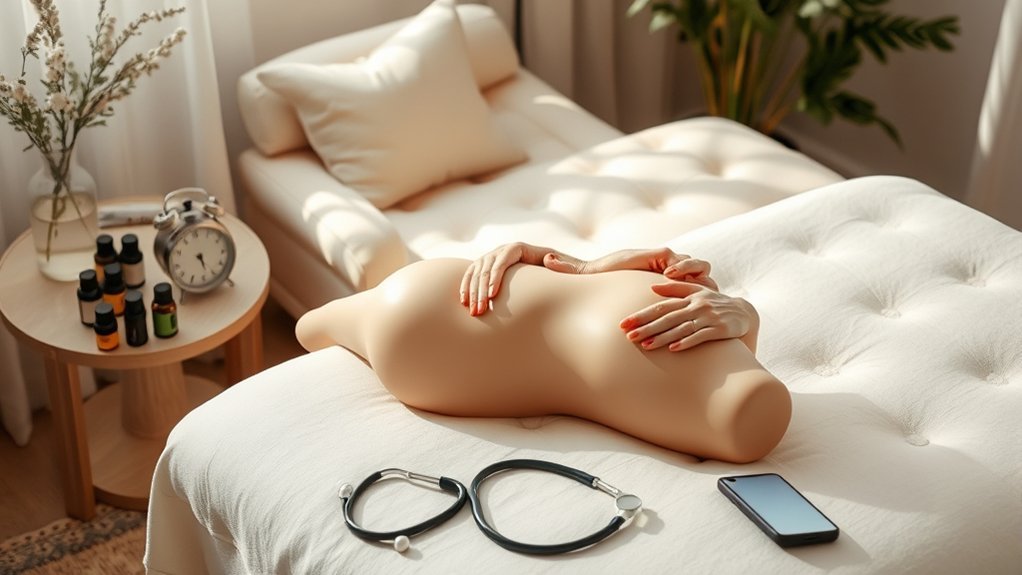When practicing perineal massage, it’s crucial to recognize the signs that may indicate a need for medical attention. You might experience discomfort or unusual symptoms that require you to stop and seek guidance. Understanding these signals can guarantee a safer experience, allowing you to benefit from the practice. So, what specific symptoms should you watch for, and how can you effectively communicate with your healthcare provider about them?
Understanding Perineal Massage

Understanding perineal massage is essential for those preparing for childbirth, as it can help reduce the risk of tearing and promote elasticity in the perineum.
Perineal massage can significantly reduce tearing risks and enhance elasticity during childbirth preparation.
This technique involves gently stretching and massaging the perineal area, typically starting around the 34th week of pregnancy. You can perform this massage yourself or have a partner assist you.
Use a natural oil to facilitate smooth movement and enhance comfort. Aim for consistent practice, ideally a few times a week, to allow your body to adapt.
Pay attention to your body’s signals; if you experience discomfort, ease off. Remember, the goal is to promote relaxation and flexibility in preparation for delivery, contributing to a more positive birthing experience.
Benefits of Perineal Massage

Perineal massage offers several benefits that can greatly enhance your childbirth experience. By practicing this technique, you can increase the elasticity of your perineum, potentially reducing the risk of tearing during delivery.
It may also help you become more aware of your pelvic area, promoting relaxation and confidence as you approach childbirth. Many women report reduced pain during labor and a shorter recovery time postpartum when they incorporate perineal massage into their routine.
Additionally, it allows you to connect with your body, fostering a sense of empowerment and control. Overall, engaging in perineal massage can contribute to a more positive birthing experience, making it a valuable practice to contemplate as you prepare for labor.
When to Start Practicing Perineal Massage

As you approach the third trimester of your pregnancy, it’s an ideal time to begin practicing perineal massage.
Starting around 34 weeks gestation can help prepare your perineum for childbirth. This timing allows your body to adapt to the technique, promoting elasticity and reducing the risk of tearing during delivery.
Starting perineal massage around 34 weeks can enhance elasticity and lower the chances of tearing during childbirth.
It’s important to incorporate this practice into your routine gently and consistently, aiming for a few times a week. Listen to your body and make adjustments based on your comfort level.
If you have any concerns or specific medical conditions, discussing your plans with your healthcare provider is vital. They can offer guidance tailored to your individual needs and guarantee you’re taking the best approach for a positive birthing experience.
How to Perform Perineal Massage Safely
To guarantee safe and effective perineal massage, start by gathering the right tools and creating a comfortable environment. You’ll need clean hands, a water-based lubricant, and a quiet space where you can relax.
Begin by washing your hands thoroughly to minimize the risk of infection. Apply a small amount of lubricant to your fingers. Sit or lie in a comfortable position, allowing your body to relax.
With one hand, gently stretch the skin around the perineum. Use your other hand to apply light pressure, moving in a circular motion. Breathe deeply and maintain a steady rhythm.
Aim for about 5-10 minutes, focusing on relaxation rather than discomfort. This practice can help increase flexibility and prepare your body for childbirth.
Signs of Discomfort or Pain
While performing perineal massage, it’s vital to be aware of any signs of discomfort or pain that may arise. If you experience sharp pain, it’s important to stop immediately and assess the situation. Mild discomfort can be normal, but persistent pain isn’t. Pay close attention to your body’s signals, as they guide you in adjusting pressure or technique.
| Signs | Action |
|---|---|
| Sharp or intense pain | Stop immediately |
| Mild discomfort | Assess and adjust |
| Numbness or tingling | Re-evaluate technique |
| Persistent discomfort | Consult a healthcare provider |
Listening to your body helps guarantee a safer experience and promotes effective perineal health.
Recognizing Abnormal Symptoms
When practicing perineal massage, it’s important to recognize any abnormal symptoms that may arise.
If you experience pain during the massage, notice unusual swelling or redness, or observe any bleeding or discharge, it’s vital to seek medical advice.
Monitoring these signs can help guarantee a safe and effective experience.
Pain During Massage
Some individuals may experience discomfort during perineal massage, and it’s important to recognize when this pain signifies an abnormal symptom.
If you encounter any of the following signs, it’s advisable to consult a healthcare professional:
- Pain that’s sharp or persistent
- Discomfort that worsens with continued massage
- Pain that radiates to other areas (like the lower back or thighs)
- Any sudden or severe pain not experienced before
- Pain accompanied by unusual feelings (like numbness or tingling)
Listening to your body is vital. While mild discomfort can be normal, significant pain often indicates that something might be wrong.
Always prioritize your well-being, and don’t hesitate to seek guidance if you’re unsure.
Unusual Swelling or Redness
How can you tell if swelling or redness during perineal massage is a cause for concern?
First, it’s essential to distinguish between normal and unusual symptoms. Mild swelling or temporary redness can be typical as your body adapts to the massage.
However, if you notice significant swelling, persistent redness, or if the area feels warm to the touch, these could signal an underlying issue.
These symptoms may indicate inflammation or an infection that requires medical attention.
Trust your instincts; if something feels off, don’t hesitate to reach out to a healthcare professional.
Early intervention can prevent complications and guarantee a safe experience, allowing you to continue perineal massage comfortably and effectively.
Bleeding or Discharge
While perineal massage can be beneficial, it’s vital to be vigilant about any unusual bleeding or discharge. Recognizing these symptoms early can help you seek appropriate care.
Here are some signs to watch for:
- Bright red blood or heavy bleeding
- Brown or dark discharge that persists
- Foul-smelling discharge
- Discharge accompanied by pain or discomfort
- Any sudden change in your usual discharge pattern
If you experience any of these symptoms, it’s important to consult your healthcare provider. They can help assess your condition and determine if further evaluation is necessary.
Importance of Consultation With Healthcare Provider
Before starting perineal massage, it’s important to consult with a healthcare provider to confirm it’s appropriate for your individual circumstances.
Your provider can assess your medical history, current conditions, and any potential risks associated with the practice. They’ll help determine if perineal massage is safe for you, especially if you have specific health concerns or complications related to pregnancy or childbirth.
Additionally, your healthcare provider can offer guidance on proper techniques and frequency to maximize benefits while minimizing discomfort. Engaging in this conversation guarantees that you’re making informed decisions about your body, promoting a healthier and more positive experience during pregnancy and delivery.
Prioritizing this consultation lays a solid foundation for your self-care journey.
Questions to Ask Your Doctor
What specific questions should you contemplate asking your doctor about perineal massage?
It’s important to clarify any uncertainties to guarantee you’re well-informed and comfortable. Here are some important questions to reflect on:
- What’re the benefits of perineal massage for me?
- How often should I practice perineal massage?
- Are there any risks or contraindications I should be aware of?
- Can you demonstrate the correct technique for me?
- When should I stop or adjust my practice?
These questions can help you gain a thorough understanding of how perineal massage can support your childbirth experience.
Understanding perineal massage can enhance your childbirth experience significantly.
Your doctor can provide tailored advice based on your individual health needs and circumstances, making sure you’re equipped with the right knowledge and skills.
Alternative Techniques and Methods
Exploring alternative techniques and methods can enhance your perineal massage practice and provide additional comfort during childbirth.
One effective method is using warm compresses before massage; this can relax the perineal tissues. Additionally, consider incorporating essential oils, like lavender or chamomile, which may promote relaxation and ease tension.
Breathing exercises can also be beneficial; focusing on deep, slow breaths helps you stay calm and centered during the process. You might find it helpful to practice visualization techniques, imagining a positive birth experience.
Finally, involving your partner in the massage can create a supportive environment and strengthen your bond. Experimenting with these alternatives can make your perineal massage more enjoyable and effective.
Resources for Further Information
To enhance your understanding of perineal massage, consider exploring recommended reading materials that provide evidence-based information.
Joining online support groups can also connect you with others who share similar experiences and questions.
Finally, consulting with a healthcare professional can offer personalized guidance tailored to your needs.
Recommended Reading Materials
While you may have a basic understanding of perineal massage, diving deeper into recommended reading materials can enhance your knowledge and skills.
These resources can provide you with essential techniques, insights, and benefits associated with perineal massage. Consider exploring the following:
- “The Birth Partner” by Penny Simkin
- “Ina May’s Guide to Childbirth” by Ina May Gaskin
- “The Womanly Art of Breastfeeding” by La Leche League International
- “Mindful Birthing” by Nancy Bardacke
- “The Complete Book of Pregnancy and Childbirth” by Sheila Kitzinger
These texts offer valuable information and can help you feel more prepared and confident as you practice perineal massage.
Online Support Groups
In addition to the recommended reading materials, online support groups offer valuable resources for anyone interested in perineal massage.
These platforms connect you with others who share similar experiences and questions, providing a supportive environment. You can find forums, social media groups, and dedicated websites focused on pregnancy and childbirth topics, including perineal care.
Engaging with these communities allows you to exchange tips, seek advice, and share personal experiences. Remember to verify the credibility of the information shared and prioritize evidence-based practices.
Connecting with others can empower you, alleviate concerns, and enhance your understanding of perineal massage techniques. These groups can be an excellent complement to your learning journey, helping you feel more prepared and confident.
Professional Consultation Options
Consulting a healthcare professional can provide you with personalized guidance and reassurance as you explore perineal massage. They can address your specific concerns, ensuring you’re well-informed and comfortable with the process.
Here are some professional consultation options you might consider:
- Obstetricians: They can offer insights tailored to your pregnancy and delivery plans.
- Midwives: They often focus on holistic approaches and can provide practical techniques.
- Pelvic Floor Therapists: These specialists can assess your pelvic health and provide targeted exercises.
- Lactation Consultants: They can help if you’re experiencing discomfort during breastfeeding, which sometimes relates to perineal issues.
- Online Telehealth Services: Convenient for quick consultations or follow-ups from the comfort of your home.
Engaging with these professionals can enhance your understanding and experience of perineal massage.
Frequently Asked Questions
Can Perineal Massage Help With Postpartum Recovery?
Yes, perineal massage can aid postpartum recovery by promoting healing, increasing blood flow, and reducing scar tissue. It’s beneficial for enhancing comfort and flexibility, so consider incorporating it into your self-care routine during recovery.
Is Perineal Massage Safe During Pregnancy?
Absolutely, perineal massage can be safe during pregnancy! However, it’s essential you consult your healthcare provider first. They’ll guide you on timing and technique, ensuring you and your baby remain healthy and comfortable throughout.
What Tools Can Assist With Perineal Massage?
You can use tools like perineal massage oils, silicone perineal massage devices, or even your fingers with gloves. These can enhance comfort, reduce friction, and make the process smoother, helping you feel more at ease.
How Often Should I Practice Perineal Massage?
Practicing perineal massage is like watering a plant; consistency fosters growth. Aim for this technique twice a week, gradually increasing frequency as you feel comfortable, ensuring you’re prepared for labor and delivery while promoting flexibility.
Can Perineal Massage Prevent Tearing During Childbirth?
Yes, perineal massage can help reduce the risk of tearing during childbirth. By increasing flexibility and elasticity in the perineal area, you’re potentially easing your body’s passage through the birth canal. Regular practice is key.
Conclusion
To summarize, practicing perineal massage can be a beneficial bonding experience, but it’s essential to prioritize your well-being. If you encounter any signs of discomfort, like sharp pain or swelling, don’t hesitate to seek support from your healthcare provider. Staying informed and proactive about your health guarantees a safer, more satisfying experience. Remember, your comfort and confidence are key components in this journey, so communicate openly and consult when necessary to cultivate a positive practice.
